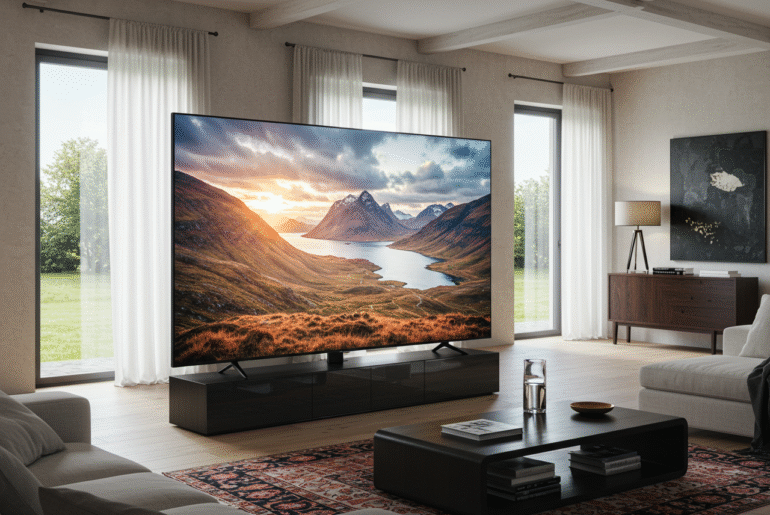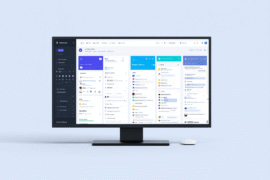This article may contain references to products or services from one or more of our advertisers or partners. We may receive compensation when you click on links to those products or services. Nonetheless, our opinions are our own.
The information presented in this article is accurate to the best of our knowledge at the time of publication. However, information is subject to change, and no guarantees are made about the continued accuracy or completeness of this content after its publication date.
The home entertainment market continues to evolve in 2025, and 8K TVs are a notable topic of discussion. 8K technology appeals to those looking to enhance their viewing experience, as it offers four times the resolution of 4K and provides improved clarity. However, because there is limited native 8K content available and the cost is high, the question remains: does it make sense to purchase an 8K TV at this time? We’ll go into great detail about 8K technology, the content that is currently available, the best places to watch it, and price comparisons. It helps people decide if upgrading is the right choice.
- 8K Technology and Its Advantages
- Assessing the Viewing Environment for 8K TVs
- Future-Proofing Home Entertainment
- Frequently Asked Questions
- What are the main benefits of 8K TVs in 2025?
- Is there enough native 8K content available?
- How do costs compare between 4K and 8K TVs?
- Will an 8K TV still work well for regular TV and streaming services?
- How important is viewing distance for enjoying 8K resolution?
- Are there potential downsides to buying an 8K TV now?
- Recommended Reads
8K Technology and Its Advantages
As of 2025, 8K TVs offer a resolution of 7680 x 4320 pixels, resulting in sharper images and finer details, especially on larger screens. The improved resolution makes textures, facial features, and small on-screen elements stand out, enhancing immersion in movies, sports, and games. Additionally, advancements in processing technology allow 8K TVs to upscale lower-resolution content effectively, improving the quality of 4K and HD media.
Benefits of 8K TVs in 2025
- Exceptional Clarity: The increased pixel density brings unprecedented sharpness, transforming visuals into near-life-like experiences.
- Advanced Upscaling: Many 8K models include AI-powered upscaling, enhancing the look of existing 4K and even HD content.
- Future Compatibility: As streaming services and gaming consoles start supporting 8K, owning such a display provides readiness for next-generation media.
Evaluating Content Availability in 2025
Despite the promise of 8K, the availability of native content remains limited in 2025. Streaming platforms have begun expanding 8K libraries, particularly in niche genres like documentaries and select big-budget films. Gaming studios are experimenting with 8K assets, but the adoption of these technologies is occurring gradually.
8K Content on Major Platforms (2025)
| Platform | Available 8K Content | Projected Growth by 2026 |
|---|---|---|
| Netflix | Nature documentaries, limited feature films | 20% increase |
| Amazon Prime Video | Select exclusive productions | 30% increase |
| YouTube | User-generated 8K videos, experimental productions | 45% increase |
| Disney+ | Select Marvel, Pixar, and Star Wars titles | 25% increase |
Most mainstream programming, such as popular series or live events, remains in 4K or lower resolutions. As a result, viewers considering an upgrade should evaluate their interest in early-access 8K content against the backdrop of current limitations.
Assessing the Viewing Environment for 8K TVs
An 8K TV’s visual advantages are maximized when the viewing environment complements the technology. Optimal room conditions allow viewers to perceive the finer details 8K delivers.
Factors to Optimize an 8K Viewing Setup
- Room Size and Distance: For best results, seating should be approximately 1.5 times the screen height away from the TV, enabling full benefit from increased resolution.
- Lighting: Adjustable or dimmable lighting reduces glare, allowing deeper color reproduction.
- Seating Arrangement: Direct, centered seating minimizes distortion of brightness and color uniformity, essential for appreciating 8K’s clarity.
Comparing 4K and 8K TV Displays
Financial considerations remain one of the most significant barriers to 8K adoption. Even as prices have declined over time, 8K TVs command a considerable premium compared to high-end 4K models.
| Feature | 4K TV | 8K TV |
|---|---|---|
| Resolution | 3840 x 2160 pixels | 7680 x 4320 pixels |
| Clarity/Detail | Excellent | Exceptional sharpness and finer details, especially on larger screens |
| Average Price (2025) | ~$600 | ~$2,000 |
| Native Content | Thousands of titles, widely available | Limited but growing (niche documentaries, select films, user-generated content, experimental gaming) |
| Upscaling Capability | Standard upscaling | Advanced AI-powered upscaling for 4K and HD content |
| Ideal Viewing Distance | 6-10 feet | 3-6 feet (to fully perceive resolution benefits) |
| Future Content Support | Established | Excellent, provides readiness for next-generation media |
| Mainstream Programming | Widely available in 4K or lower | Most remains in 4K or lower, upscaled for 8K display |
| Primary Advantage | Excellent visual experience at an affordable price | Unprecedented sharpness, future-proofing |
| Primary Downside | Less future-proof for emerging 8K content | High cost, limited native content availability |
| Target Consumer | Most consumers seeking a high-quality viewing experience | Enthusiasts, early adopters, and those with specific viewing environments |
Voted "Best Overall Budgeting App" by Forbes and WSJ
Monarch Money helps you budget, track spending, set goals, and plan your financial future—all in one app.
Get 50% OFF your first year with code MONARCHVIP
Future-Proofing Home Entertainment
Investing in an 8K TV can future-proof a home entertainment system by providing compatibility with emerging 8K content and next-generation gaming platforms. Upscaling technology further improves the presentation of existing 4K and HD media. However, buyers should balance the appeal of early adoption against potential waiting periods for widespread 8K content.
Factors to Consider
- Price vs. Content Availability: Evaluate whether limited 8K content aligns with the cost premium.
- Longevity: High-quality 4K TVs offer years of continued relevance with extensive content support.
- Technology Cycle: Future advancements may bring more affordable 8K options or new display technologies altogether.
Is Investing in an 8K TV Worth It in 2025?
Whether or not to buy an 8K TV in 2025 will depend on how you like to watch TV, how your room is set up, and how much money you have. Enthusiasts and early adopters like the better picture quality and the fact that it will last longer, but for most people, the lack of native content and the high cost may outweigh the benefits. For a lot of people, sticking with a high-end 4K TV is still the best choice until 8K content becomes more common.
Frequently Asked Questions
What are the main benefits of 8K TVs in 2025?
8K TVs deliver higher resolution and improved detail clarity, particularly on large screens, enhancing immersion in movies, sports, and games. Many also feature advanced upscaling to improve lower-resolution content.
Is there enough native 8K content available?
While streaming platforms have begun offering some 8K documentaries and feature films, native 8K content remains limited. The majority of viewing still involves upscaled 4K material.
How do costs compare between 4K and 8K TVs?
In 2025, 8K TVs are priced around $3,000 on average, significantly higher than premium 4K models at approximately $1,200. The price difference should be weighed against available content and viewing habits.
Will an 8K TV still work well for regular TV and streaming services?
Yes, 8K TVs support standard HD and 4K content through advanced upscaling, but the full benefits of native 8K resolution won’t be realized without true 8K material.
How important is viewing distance for enjoying 8K resolution?
Very important. Sitting too far away negates the visibility of 8K’s added detail. For a typical 65-inch 8K screen, an optimal distance is around 3–6 feet.
Are there potential downsides to buying an 8K TV now?
Higher costs, limited native content, and the possibility of more affordable or improved 8K options in the coming years are key considerations before purchasing.

Reviewed and edited by Albert Fang.
See a typo or want to suggest an edit/revision to the content? Use the contact us form to provide feedback.
At FangWallet, we value editorial integrity and open collaboration in curating quality content for readers to enjoy. Much appreciated for the assist.
Did you like our article and find it insightful? We encourage sharing the article link with family and friends to benefit as well - better yet, sharing on social media. Thank you for the support! 🍉
Article Title: Are 8K TVs Worth It in 2025?
https://fangwallet.com/2025/07/03/are-8k-tvs-worth-it-in-2025/The FangWallet Promise
FangWallet is an editorially independent resource - founded on breaking down challenging financial concepts for anyone to understand since 2014. While we adhere to editorial integrity, note that this post may contain references to products from our partners.
The FangWallet promise is always to have your best interest in mind and be transparent and honest about the financial picture.
Become an Insider

Subscribe to get a free daily budget planner printable to help get your money on track!
Make passive money the right way. No spam.
Editorial Disclaimer: The editorial content on this page is not provided by any of the companies mentioned. The opinions expressed here are the author's alone.
The content of this website is for informational purposes only and does not represent investment advice, or an offer or solicitation to buy or sell any security, investment, or product. Investors are encouraged to do their own due diligence, and, if necessary, consult professional advising before making any investment decisions. Investing involves a high degree of risk, and financial losses may occur including the potential loss of principal.
Source Citation References:
+ Inspo
Fruhlinger, J. (2018, January 26). The average price of 4K TVs dove 40% this fall. The Business of Business. https://www.businessofbusiness.com/articles/average-price-of-4k-tvs-dove-by-over-40-this-fall/












































